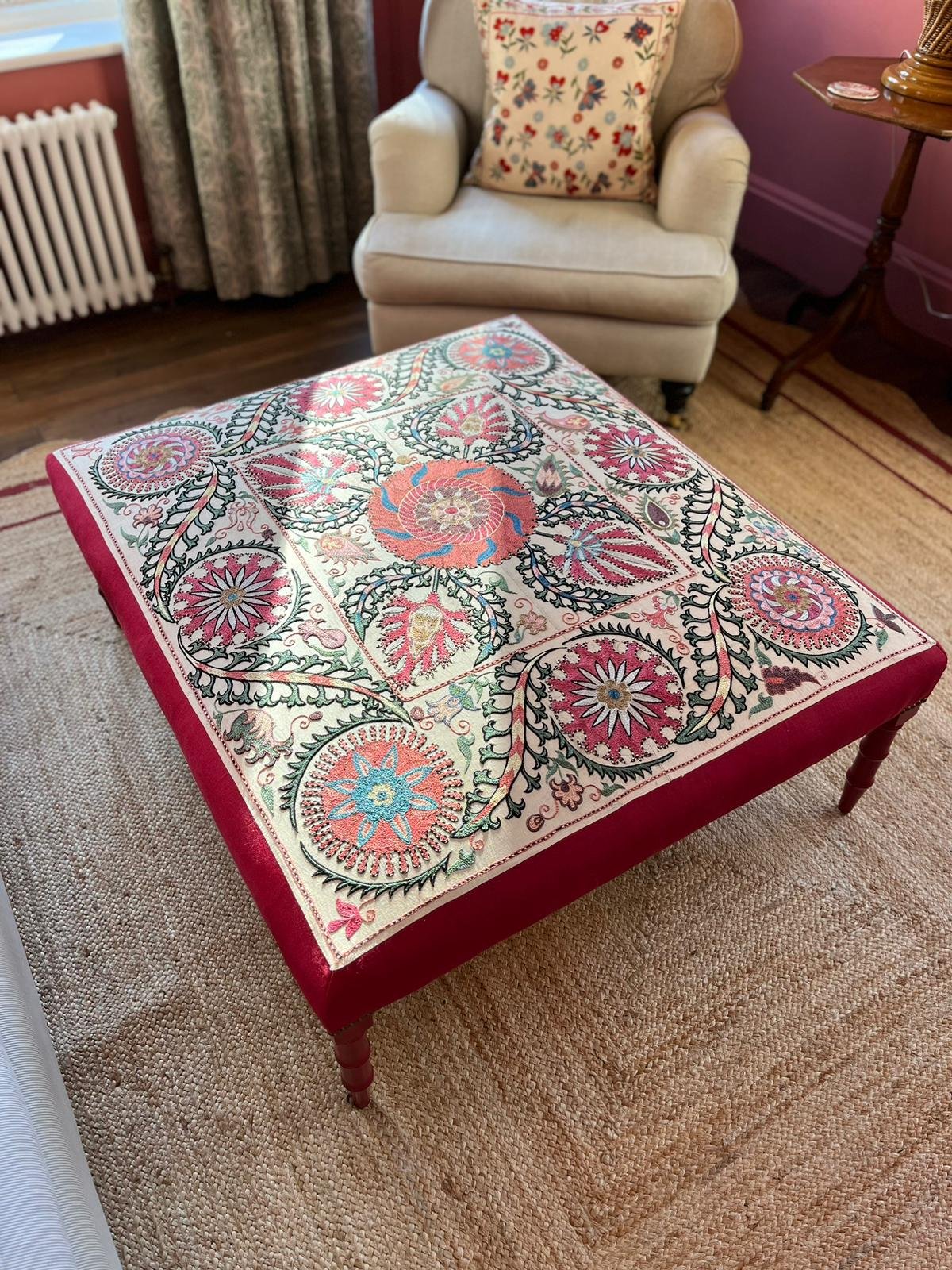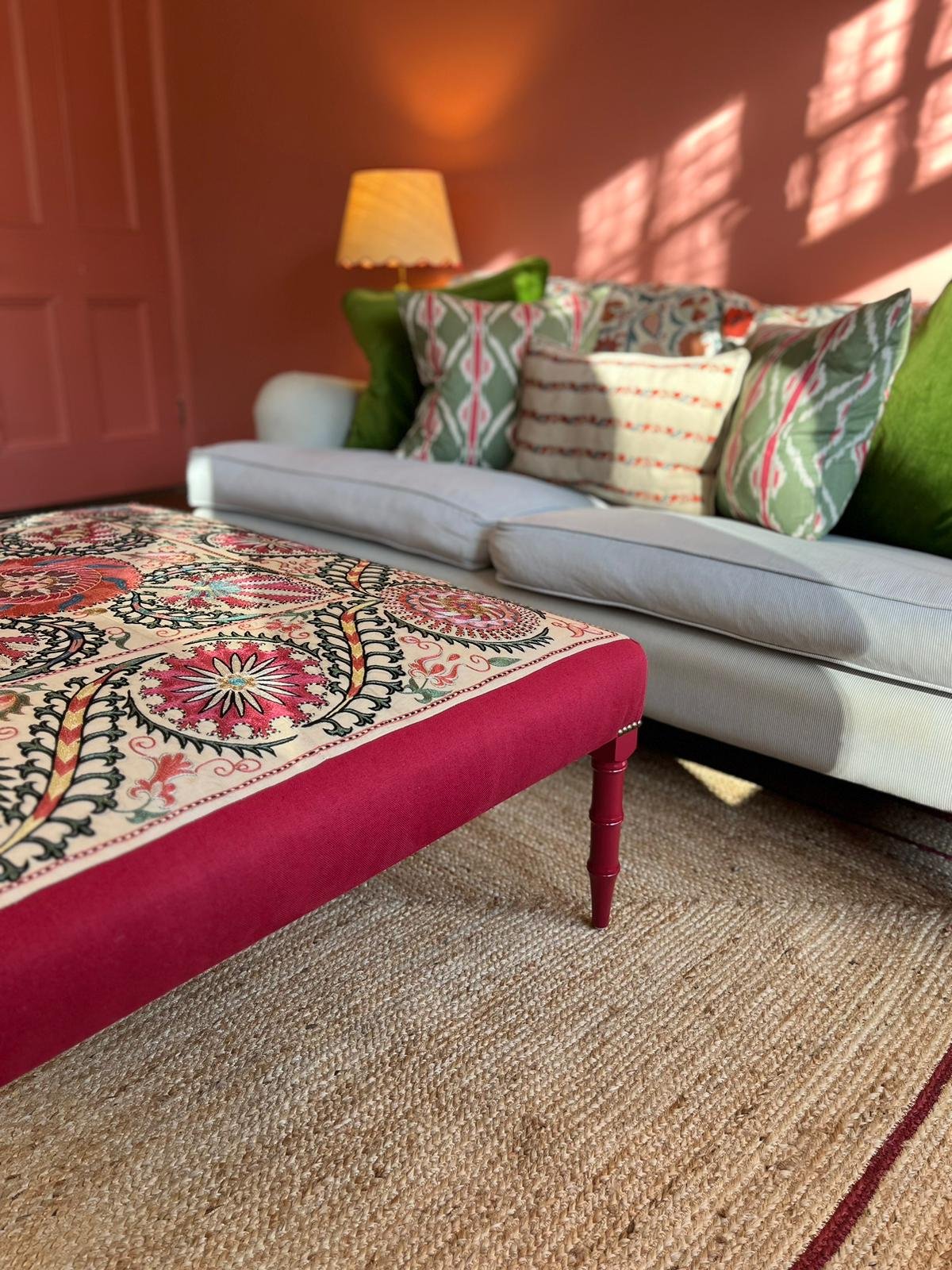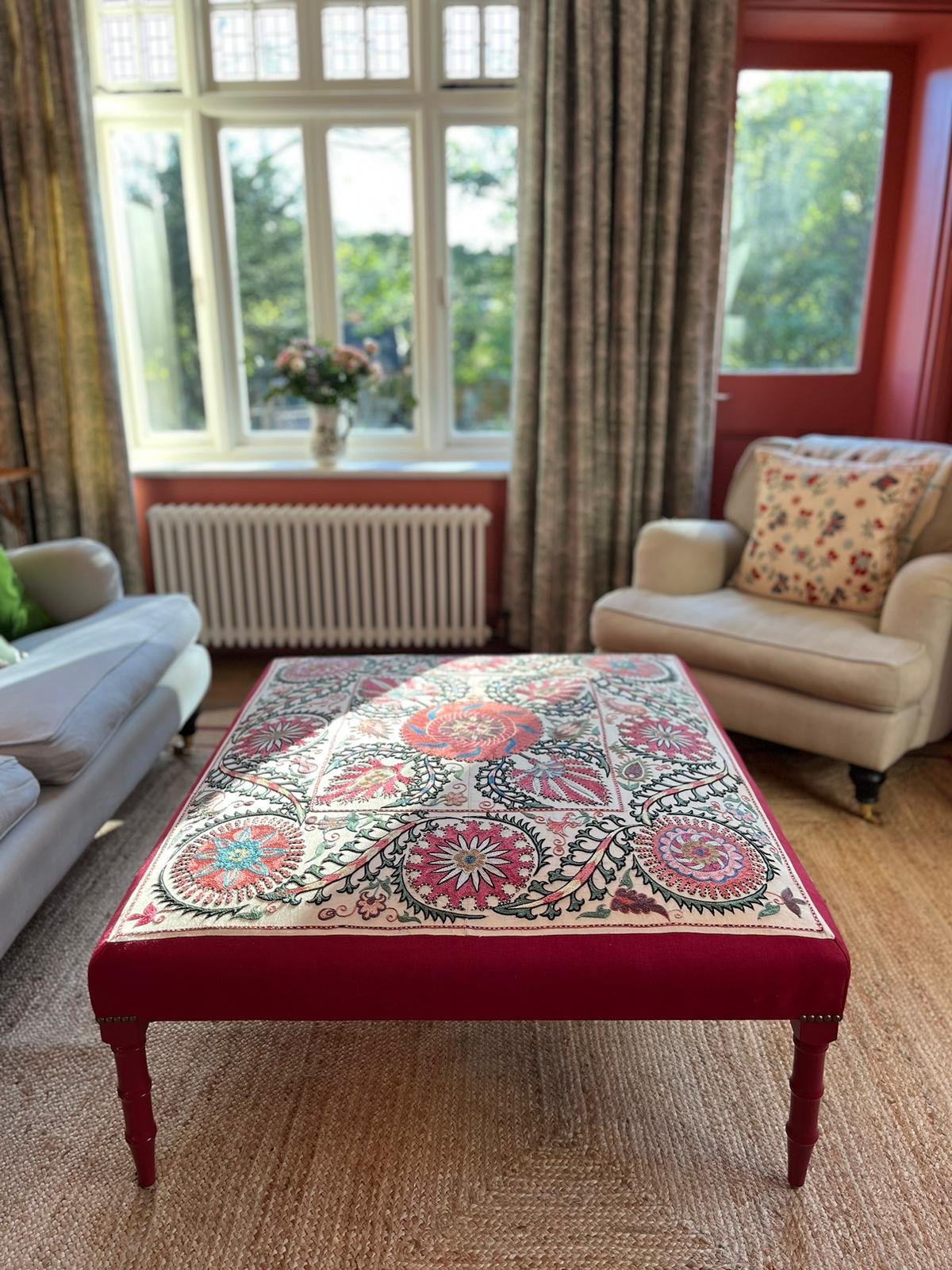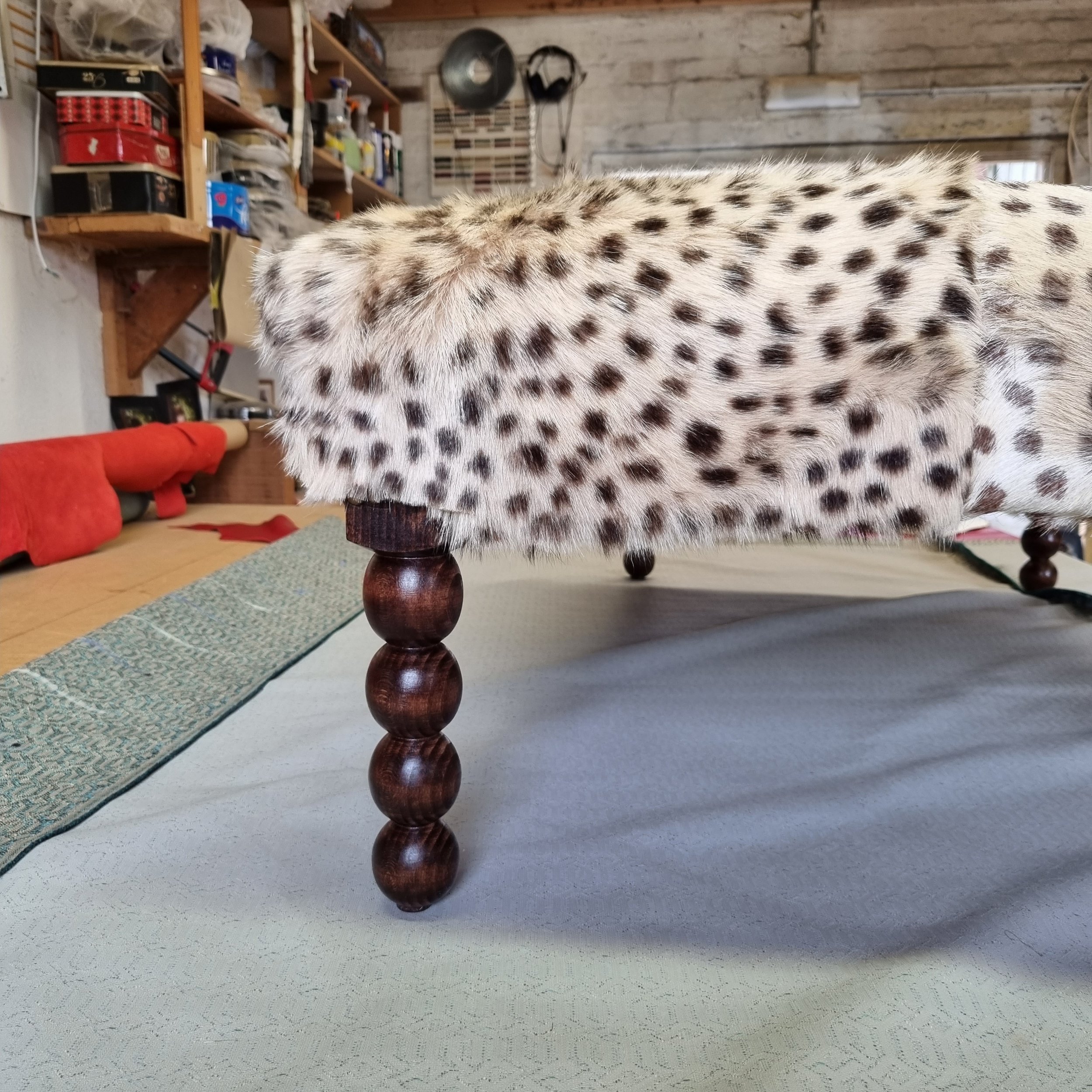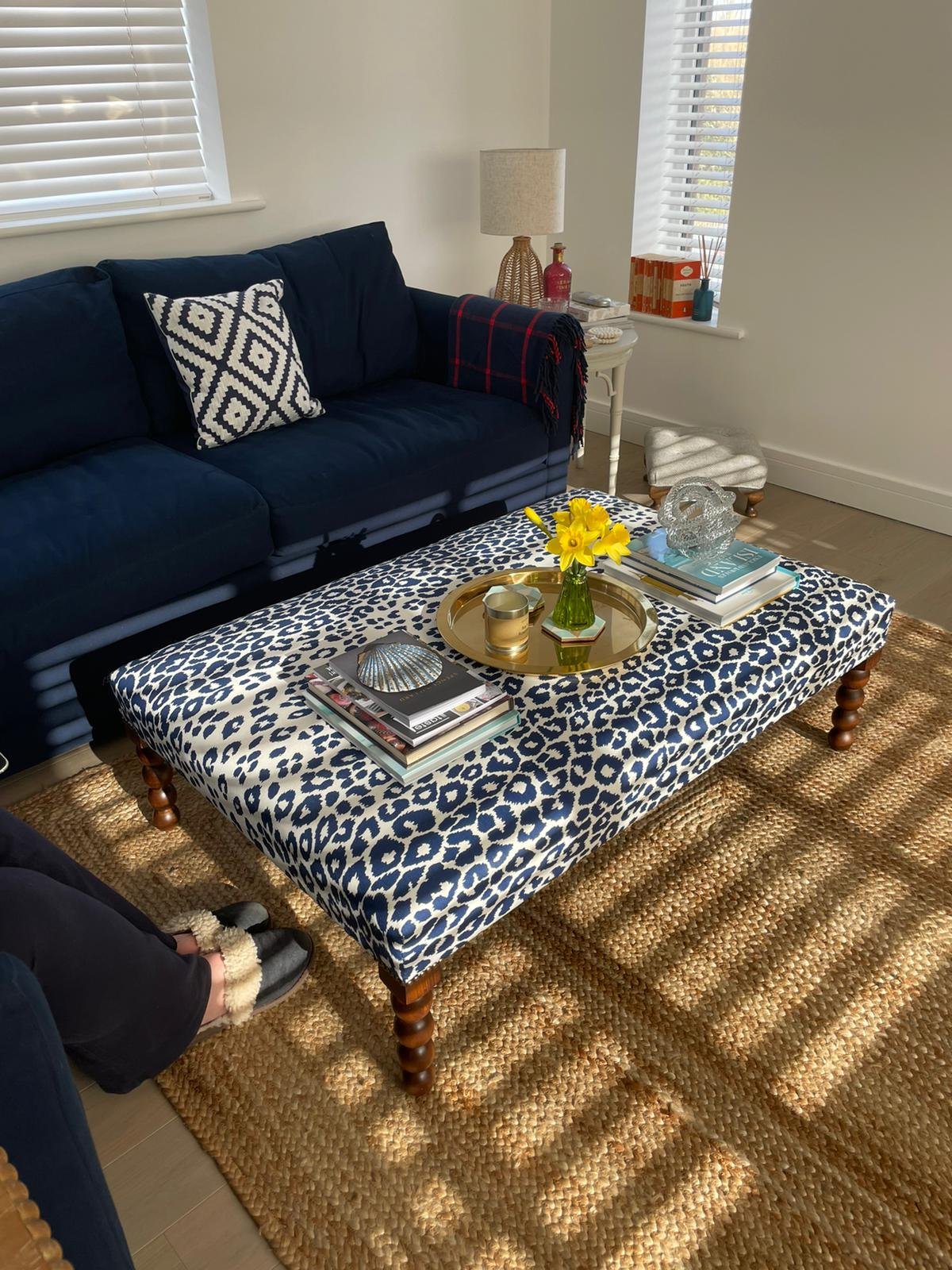Living Room Moodboard
How we style our Suzani Ottoman
We love helping our customers choose fabrics for our furniture to compliment their rooms. Whether it is with patterned fabrics to create a zing in an otherwise muted room, or a complimentary plain colour or texture to add warmth to a busier room. With this in mind we decided to create a few schemes for the footstool in our collection, our Suzani Ottoman.
The first is how Holly from Sourced by Holly has styled it in her home, bringing the same colours as the ottoman to her walls and then keeping the rest of the room simple with neutral colours and small patterns on the furniture and accessories.
The second moodboard uses a softer colour on the walls and highlights the neutral and green tones in the embroidery on the ottoman. The walls woudl be in a soft sage with similar tones on the velvet sofa and then pops of pinky red in the artwork and accessories.
The key to designing any room is to make sure it is all linked up - hence the same reds on the cushions, lampshades and art as is on the ottoman, and greens on the walls, sofa and ottoman. This way you can use a pattern in any room without it being as impactful as the safe among you fear.
Lights, Jim Lawrence, shades Fermoie.
Art, Sammy Little
Braid on Curtains, Colefax & Fowler
Sofa, F+P Interiors
Cushions, Sourced by Holly
Rug, Birdie Fortescue, carpet Alternative Flooring
Ottoman and Side table, The Modern Antique Project
Chair, 1st Dibs
Choosing Fabric
After choosing the piece of furniture you want to order, the next important decision you need to make is what fabric you want it in!
When we first started The Modern Antique Project we were determined to help make that decision by offering a selection of both patterned and plain fabrics. We know the choice of fabrics is endless and can be very difficult to choose from the hundreds and thousands out there.
Sometimes though you want something a bit different, so where do you look?
We partnered with F+P Interiors on our Sitting Room collection and they used fabrics from design house GP & J Baker as well as Ian Sanderson. Both these fabrics look really great on our furniture and come in a great colour range. The Somana fabric on the ottoman is one of our most popular styles too. Not only do they sell these designers but over 80 others, so their website is always the best place to start when looking for inspiration or something in particular.
Two of our latest orders have been using goat hides, one a coloured leather and the other a hairy spotty fur! These were supplied by the customer from Howe at 36 Bourne St.
Our next stop is Haines Collection, the eco friendly choice as they sell end of line, discontinued, ethically made and defected fabrics. We like them best for picking up Christopher Farr and Fermoie. The majority of fabrics are a metre or less - great for an ottoman!
A browse around Etsy is great for finding antique or ethnic pieces such as a beautiful Turkish embroidery, or a South American weave.
Lastly, we couldn’t not tell you about Sourced by Holly and her wonderful Suzanis! Her beautiful silk embroideries are so inspiring and a piece of art in itself.
So now you know where to look, how do you decide what to choose?
The best place to start is choosing a main colour that you want to bring out that is usually already in your room, or you are planning on adding to the room. It can be a colour that is part of the pattern on other pieces of furniture or cushions. Do you want a plain or pattern, flat or textured.
We recently had a client with two neutral sofas, neutral carpet and neutral walls so she wanted to bring in some colour on her ottoman. She had a few cushions on the sofas in red greens and golds so we picked up the red colour and then found a textured chenille from Titley & Marr like fabric that upholstered beautifully and looks very elegant.
In another instance the client wanted a blue patterned fabric and we were able to stear them towards the Caspian fabric collection from GP & J Baker that we used for our F+P Interiors collection, using a design that picked up a few colours in the room whilst also bringing a more playful edge.
Contact us today if you need help sourcing fabrics.
How to measure for an Ottoman
A quick guide on how to measure for the perfect sized ottoman for your space.
The beauty of ordering a bespoke piece of furniture is that you can have it the exact size you want and need, and in you favourite fabric - pretty dreamy! The tricky thing is deciding what exactly that size should be...
Our standard size of 110 x 60cms is pretty perfect for most homes but you may want to add a bit here or there if you’ve got quite big sofas. If you have 1 x sofa and 1 x armchair then I don’t think you can go wrong with 110 x 60cms. In my own home I have two large 2 seaters at 187 & 190cms long so I know I needed the same length as standard but just a bit deeper so went with 110 x 70cms.
When measuring up for an ottoman there are a few key things to consider:
Current confirgurations
Future configurations (if you are in a rental property and don’t own all the furniture or you don’t LOVE all your existing furniture so know you will change a piece in the not too distant furture
How you move about the room it is going in
So first things first, measure out the furniture going around the ottoman. You then want to make an average length and take off about a third to make your ideal size. You want 30/40 cms of sofa either side of the ottoman when it is in the middle so the people sitting on each seat cushion can still use it (if facing them).
It is also worth considering the size of your rug as you don’t want the ottoman to completely cover it up.
Lastly the height. Your ottoman needs to be below the seat height of your sofa/chair which will usually 45-50cms to the top piping line. Our ottoman comes at 37 - 40cms high so if you do want any higher you would need to specify for a taller leg.
This ottoman is L110 x W70cms making it fit to roughly 2/3 of both sofas whilst also allowing enough to room to walk around and show off the rug.
Choosing art for your home
When choosing art for your home it is key to get a variety of different mediums to create depth and intrigue.
Decorating a home needs more than pretty paint and beautiful furniture. You need pictures on the wall to give character and intrigue to a room. And a selection of different styles and mediums is key to creating depth.
Choosing and finding art can be quite a daunting task, especially when you are doing it with someone else as you can quickly discover while you’re a sucker for a moody landscape, your partner likes a frame filled with food, people or animals.
The next thing you need to decide is whether you want a series or a gallery. We have both in our home, depending where you are in the house. Up the stairs we have a series of vintage photographs from the Middle East. When framing a series while you can’t always make them the same size (depends on the shape of the images) you should always put them in the same colour frames. I recently read that the easiest way to choose the colour of the frame is to pick the prominent colour in the image. This is fine with black and white photos or moody landscapes as you can rely of black, white or natural. It becomes tricky when you have colourful images as it almost seems a shame to put them in something so plain. Thank goodness for sample pots of paint and wooden frames! While a hassle it does mean you create something a little more exciting.
Adding paintings and embroideries gives textures to a room as too many prints can appear flat. Embroideries are now so easy to come by thanks to the insurgence of Suzanis on the market and great companies like The Fabled Thread which teach you how to use multiple stitches on their beautiful designs.
A very lovely expert once told me that you shouldn’t buy art for how much it will cost, buy because you love it and have to have it. You should love and appreciate what you buy and and added bonus if it ends up becoming worth something in years to come.
Prints - The V&A shop has long been a favourite of mine, and is a great way to find prints of artwork, drawings and ancient textiles. Their collection continuously changes depending on their exhibitions so it is always worth a check. Likewise when visiting an exhibition it’s always worth a check in the gift shop for a limited edition print. If you have a favourite artist they often will have a selection of limited edition prints on their website for a fraction of the cost of an original. Always get one with a fresh signature so it is more authentic and not mass produced.
Books - It may seem sacrilege cutting up a book for the pretty pictures but if you do it nicely you can still keep the rest of it. I found this is particularly good for decorating childrens rooms, and bathrooms. Likewise with programmes such as for Glyndebourne as each year a different artist designs them. Pictures from books are also a good way of creating a series. Two Artists at Home have a brilliant selection of vintage books filled with pretty pictures. A great example is in the house of Chloe Willis interior designer at from Sibyl Colefax & John Fowler where she has used pictures from a book on Chinese sampans.
Embroidery - Etsy is the best place to find embroideries from around the world or vintage. Beautiful Suzanis from Uzbekistan or weaves from South America can easily be fixed to your walls either in a frame, using pegs or hooks. Alternatively make your own using inspiration from the likes of The Fabled Thread or Thread the Word.
Paintings - The best place for paintings is always going to be galleries, antique shops and auction houses. However, you can pick up a bargain online if you know what you are looking for. Ebay is a great source so long as you have a specific artist or style in mind.
Photography - Photographs can be found everywhere and anywhere and I love them because they tell not only the story of the subject but also who took them. Wandering the windy streets of Old Jerusalem you will come across little cubby holes selling old photographs of camels camped outside Damascus gate. A great source of sporting, fashion, film photographs is ArtPhoto Ltd. Alternitively print off your own images from your travels.
Instagram will always be an amazing source for your interiors and finding art is no different. I have bought photographs from photographers I admire by DMing them to ask if they sell prints (I have yet to be turned down), and paintings much the same way. There are lots of lovely antique art sellers too out there like Discerning Palette, Etalage, Tat London, Wallis Antiques and Sourced by Holly among many many others!
Sourcing Antiques
Adding antiques to your home is a great way to add depth and character. Here are my favourite places to source treasures.
The idea for The Modern Antique Project came from my love of antique furniture. I love the stories you can imagine for each piece thanks to knocks and nicks, bodge mending jobs and scribbles on the back or even just how old it is and what you know of the history of the time the piece was made. There is always the difficulty though of finding items that fit your space which is why I decided to set up a company replicating pieces I love but making them fit our modern lives.
However, that doesn’t mean I have stopped buying antiques! I would say we have more old furniture in our house than new. In our environmentally conscious world why wouldn’t you buy second hand pieces that have been stored in a garage unused, or need a bit of wood glue and paint to give a new lease of life instead of adding to a world already over-filled with stuff?
Below are a few places I use to source items and what I look for in each place.
If I am looking for furniture that I want to repaint - i.e. a chest of drawers for a guest bedroom or nursery - then my first port of call will be Facebook marketplace. You can often find real treasures thanks to people clearing houses and unwilling to get someone in to do it for them. I recently found a pretty antique chest of drawers with shaped gallery back that needed wood glue and paint but after a bit of TLC looks great, and adds character to our nursery. Too often childrens bedrooms is filled with new furniture which can make a space too clinical and flat.
Another favourite is reclamation yards and house clearance shops. Two big butler sinks were sourced from Authentic Reclaimation in East Sussex for £80 each. House clearance shops are also a great way to pick up art to fill your walls. On a recent holiday in France I found a pretty mid-century oil painting that gives just the texture needed for a gallery wall. Another great find was a gorgeous early 20th Century refectory table from a house clearance shop in Heathfield for our kitchen.
Local antique shops, fairs and auction houses are best for decorative pieces you want to spend a bit more money on, or impact furniture like a kitchen dresser or sitting room side tables and bookshelves. Gorringes in Lewes is my favourite auction house for furniture and art as nearly every week they have some real gems. And antique shops in villages are a great place to find mirrors and pottery and glassware.
Instagram has now become an amazing place to find antique furniture, lighting and art but you have to be quick! I love Petit Tresor, Wallis Antiques and Sheps House Clear for a mix of European and English pieces.
When I am feeling brave I’ll sit on Ebay and have a search but I think you need to know exactly what you are looking for to be successful. I inherited a small Parker Knoll armchair from an aged aunt and wanted another so sat on ebay for about 2 days until I found one in desperate need of a little love and therefore ideal for what I was looking for. And it was only £5! I’ve recently discovered art on ebay too. I bought two little Haitian paintings from a lady in France that are just the right colours for kitchen and adds some much needed texture and zing.
Below are a few pieces recently sourced.

